A report shows more than nine out of 10 former post-secondary students surveyed were satisfied or very satisfied with the education or training they received in British Columbia, but a closer reading reveals that it tends to funnel men and women into distinct job categories, with women generally earning less than men.
The findings appear in the 2018 edition of BC Students Outcomes, an annual report that asks former students to evaluate their education, report employment outcomes, and describe their finances among lines of questions. Funding for the report comes from the Ministry of Advanced Education, Skills and Training, the Industry Training Authority, and from B.C.’s public post-secondary institutions. Government uses it for accountability and policy development, institutions for program review and faculty development, and the public uses it for program choices and career planning among other reasons.
RELATED: Poll: Are you stressed about back to school costs?
The report paves a broadly positive picture of baccalaureate programs; diploma, associate degree and certificate programs; trades foundation and trades-related vocational programs; and apprenticeship programs in British Columbia. In 2018, 92 per cent of the former post-secondary students surveyed were satisfied or very satisfied with the education or training they received, according to the report.
But various outcomes can differ significantly. For example, 90 per cent of baccalaureate program graduates had entered the labour force after graduation, but nearly half of them (46 per cent) also took further studies with nearly one-third (28 per cent) going on to master’s degrees.
RELATED: Victoria post-secondary schools reveal most popular programs
Notably, a combined 41 per cent pursued degrees either outside the traditional academic trilogy of baccalaureate, master’s and doctoral degree, or below them. These figures further underscore long-held suspicions that a baccalaureate degree — once a ticket into the upper-middle class, and beyond — has become a stepping stone.
The unemployment rate of baccalaureate program graduates was also higher when compared to other categories of students. For example, 97 per cent of apprenticeship students reported being in the labour force, with an unemployment rate of 4.3 per cent — around 30 per cent lower than those of baccalaureate program graduates.
This said, baccalaureate graduates “were very likely to say the quality of instruction they received was very good or good.” According to the report, a large majority said the core program of required courses “did a very good or good job providing a comprehensive understanding of their field of study,” with three-quarters saying they would take the same program again.
The majority of graduates also said their programs helped them develop skills, especially the ability to analyze and think critically, with 91 per cent saying that their programs taught them analysis and critical thinking, while another 89 per cent said their programs showed them to learn independently. Economists consider such skills critical in a dynamic, increasingly digital information-based society.
RELATED: Province funds $30M trades centre for Camosun
The numbers also reveal a distinct sociology and different earning levels associated with different degrees.
More than six out of 10 baccalaureate program graduates were women. Women also accounted for the majority of graduates from diploma (55 per cent) and certificate (73 per cent) programs. By contrast, men made of 72 per cent of trades-related vocational and 80 per cent of trades foundation programs, as well as 93 per cent of apprenticeship students.
Looking at job categories, four out of 10 baccalaureate program graduates leave their schools with degrees in arts and sciences, with the social sciences and the humanities making up the bulk of graduates. Graduates of associate degrees, diplomas and certificate programs spread across more categories, with health, business management and arts and sciences adding up to 63 per cent.
Graduates of apprenticeship, trades foundation and trades-related vocational programs, meanwhile, show the greatest diversity, with no job category attracting more than 20 per cent of graduates, ranging from electrician (20 per cent) to other construction trades (two per cent). Plumbing, for example, absorbs as many graduates — nine per cent — as carpentry and the culinary arts and personal services.
These graduates can also look forward to higher hourly wages. Apprenticeship graduates report earning a median hourly wage of $32 when working full time. By contrast, the median hourly wage for diploma and certificate graduates employed full time was $22.38. Full-time working graduates of baccalaureate programs meanwhile recorded a median annual salary of $55,000. Assuming a 40-hour work week over 52 weeks (2,080 hours), this figure would translate to an hourly wage of $26.44.
In short, men dominate higher paying jobs in the low-unemployment trade sector, while women find themselves competing against each other in lower paying industries, following graduation from provincial secondary institutions. In fact, the figures suggest many will pursue additional education, a move likely cutting into their earning years and leading to more debt.
According to the report, the average debt of baccalaureate program graduates is $26,000. This said, fewer than half of baccalaureate respondents actually incur debt during their studies.
